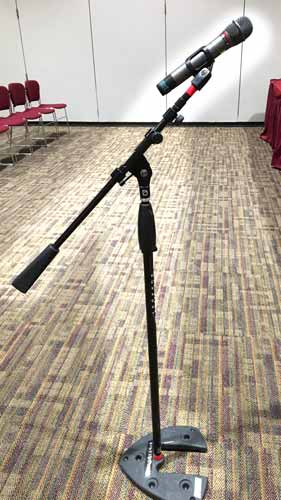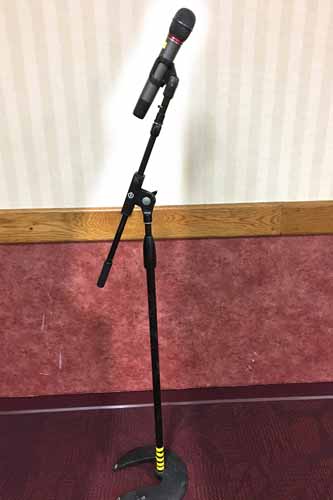Boom Microphone Stand

NOTE: The two lines of yellow tape on the stand are used to differentiate similar microphones or equipment from a distance (such as at the Front of House (FOH) position). E.g. A stage setup has three boom mic stands on stage. All of the stands have the same microphone on the stand. The tape on the stands can be used to determine which mic is being used while mixing the live audio for the event.
Basic Information
Boom mic stands are stored in the:
- Tech Crew office; and
- Ballroom equipment cabinet.
Setup Considerations

This boom stand is CORRECTLY preset / set due to the following:
- The U-shaped area on the mic stand base is pointed in toward the user.
- The first extension tube of the boom arm is:
- extended all the way upward until the stop point of the boom arm, and
- raised to a 33-45 degree angle.
- The second extension tube (inside the first) [if the stand has one] may or may not be extended depending on the height of the user.
- The microphone is positioned horizontally and the diaphram of the mic is pointed directly at the emanation of a user's voice.
NOTE: This mic stand has a U-shaped area cut from the base of the stand. This feature is used to more easily stack mic stands on top of each other for storage or transportation.

This boom stand is INCORRECTLY preset / set due to the following:
- The first extension tube of the boom arm is not extended all the way upward to the stop point of the boom arm. In this setup, it may be expected that the second extension tube (inside the first) [if the stand has one] may be expected to easily make up any additional gap between the mic and the user.
- The microphone is not positioned horizontally and the diaphram of the mic is not pointed directly at the user's mouth, or the emanation of a user's voice.
NOTE: This mic stand has a counter-weight on the lower part of the boom arm. The counter-weight is used to counter the effect of gravity for some set ups. E.g. If a mic is heavy, the counter-weight will help to balance the weight of the mic so that the mic and stand do not move from its set position. If a boom stand is set with it's arms fully extended (such as with a vocal mic for a pianist), the counter-weight helps to balance the length of the extended mic.
NOTE: This mic stand has red tape around the bottom of the down-shaft of the stand which indicates that the stands belongs in the Ballroom storage cabinet.

This boom stand is INCORRECTLY preset / set due to the following:
- The U-shaped area on the mic stand base is NOT pointed in toward the user. In this setup the base is pointed away from the user.
- The first extension tube of the boom arm is not extended all the way upward to the stop point of the boom arm. In this setup, it may be expected that the second extension tube (inside the first) [if the stand has one] may be expected to easily make up any additional gap between the mic and the user.
- The first extension tube of the boom arm is not extended to a 33-45 degree angle. The function and intent of the boom arm is negated due to its steep angle.
- The microphone is not positioned horizontally and the diaphram of the mic is pointed at the ceiling (and ceiling speakers, increasing the chance of experiencing feedback).
See also microphone quick clips.
